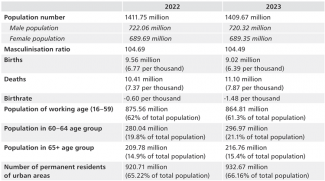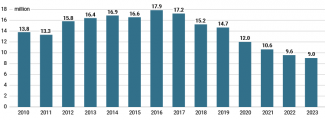A disaster of their own making. The demographic crisis in China
China is currently facing demographic problems which closely resemble those seen in most developed countries. However, it has had less time to deal with the consequences of the population crisis. Furthermore, as the Chinese public is clearly less prosperous, the crisis has had a more negative impact on the country’s residents and economy. All this is an effect of the family policy mistakes that have been made since the early 1980s, as well as the system’s prolonged inability to make swift adjustments, despite the emergence of unfavourable demographic trends at the turn of the century.
Under Xi Jinping’s leadership, China has withdrawn from the ‘one-child policy’ and started promoting a model of larger families. However, the Chinese public is undergoing cultural changes that contradict the government’s pronatalist approach. Add to this budget constraints, minimal immigration and the rapidly declining number of women of reproductive age, and this problem becomes practically unsolvable. As a result, the demographic downturn will significantly impact both domestic and foreign policy in China.
According to data (see Appendix) published on 17 January by the National Bureau of Statistics of China (NBS), the country’s population at the end of 2023 stood at 1.409 billion, 2.08 million smaller than the previous year. This marks the second consecutive year of demographic decline, with a larger decrease than in 2022, when it was 0.85 million. At the same time, there was a larger decline (by over 10 million) in the working-age group (16–59 years), which numbers 864.8 million people, and its share in total population has dropped to 61.3%.
The NBS did not provide data on the number of women and men in specific age groups, but it can be assumed that a strong gender disparity persists within the reproductive age group (15–49), with the number of men estimated to be dozens of millions higher. The masculinisation ratio for the entire population is still high (104.49), which is a result of cultural preferences for having sons and the associated trend in selective abortions.[1] Further proof of the downward progression includes the decreasing birthrate (from 6.77 to 6.39) coupled with the growing mortality rate. The latter can only be partially explained by giving up the ‘zero COVID’ strategy last year;[2] it is a consequence of the general increase in the share of elderly people, and will only continue to grow in the future.
The demographic situation in China is likely even more challenging than suggested by official NBS data. Some demographers, such as Yi Fuxian, Huang Wenzheng and Wang Feng, estimate that China’s population began to decrease as early as 2018 and never exceeded 1.3 billion. A data leak from the population registry in July 2022 revealed a registered population of 1.28 billion.[3] Previously, the government in Beijing assumed that the country’s population would start to shrink no earlier than 2027. However, data provided by independent researchers and forecasts from the UN Department of Economic and Social Affairs (UNDESA) forced the Chinese government to adjust the NBS’s data. According to UNDESA estimates in April 2023, India – with a population of 1.425 billion – outpaced China as the world’s most populous nation.
It seems evident that China’s population will continue to decline at least until the end of this century, and the process will accelerate each year. In 2022, UNDESA presented new forecasts regarding demographic changes in China. According to them, its population will fall below 770 million by 2100. The estimates were adjusted because the fertility rate of women had fallen below 1.2 (in 2022, it was 1.18), placing China among the countries with the lowest birthrate in the world (a minimum of 2.1 is needed to maintain population stability). In turn, forecasts based on the assumption that China’s current population is below 1.3 billion indicate that this number will fall below 650 million by the end of the century.
From the ‘one-child’ to the ‘three-child’ policy
The roots of the current demographic crisis can be traced back to the era of Mao Zedong.[4] Following the famine of 1959–61, the decade from 1962 to 1971 saw a demographic explosion, when 277.9 million children were born (for comparison, only a third as many children are expected to be born between 2021 and 2030). In response, the government imposed the first restrictions on childbearing in 1970, known as the ‘two-child policy’. Despite these measures, local authorities continued to report significant (albeit decreasing) population growth. This not only led to the tightening of family planning policy in the 1980s and a limit on the number of children to one in urban areas and two in rural areas (and only if the first child was a girl), but also to the use of draconian measures to enforce these regulations: these included forced sterilisation and abortion, even in advanced pregnancies.
From its inception the ‘one-child policy’ sparked serious controversies among demographers who warned of its catastrophic consequences.[5] The leaders of the Chinese Communist Party (CCP) disregarded their warnings about the long-term effects of the new regulations, as they were primarily interested in swiftly curbing population growth. Their assessment of the situation was also influenced by the fact that local authorities at various levels inflated the number of births they reported in order to get higher subsidies from the central budget, as their value depended to a significant extent on the size of the population.[6] When the restrictions were already in place, local authorities were also tempted to report a higher number of births in one year and then a lower number in the next, thus demonstrating their ‘success’ in reducing population growth.
It is likely that the central government only got a realistic picture of China’s population structure in the 2000s. The situation at the turn of the century changed due to the gradual digitisation of household registration (hukou) databases and the associated residential registration system. However, the party-state apparatus resisted the need to modify the family policy. The great power it gained over the Chinese public as part of the ‘one-child policy’ led to pathological behaviour and abuses. Moreover, the local structures of the National Family Planning Commission established in 1981 (renamed the National Population and Family Planning Commission in 2003) became an important player in the CCP’s domestic policy, supporting various factions within its regional and central structures.
It was only after Xi Jinping came to power that the resistance of the local apparatus was broken, and the commission was dissolved in 2013. It was replaced with a new body, the National Health and Family Planning Commission. In 2015, in response to the demographic crisis, couples were allowed to have two children. The restrictions were further relaxed in 2021, and this limit was raised to three. However, the family policy liberalisation has led only to a slight increase in births in 2016–17, and the negative trend returned soon thereafter (see Appendix).
Birthrate vs cultural changes in China
The declining birthrate in China is linked to several economic and cultural factors. The cost of raising a child in this country is nearly seven times (6.9) China’s per capita GDP, and is much higher than in the United States (4.11) or Japan (4.26).[7] Additionally, the level of social security and healthcare coverage is quite low, so the working population have to support their aging parents. For instance, a married couple of only children must support four parents and save part of their income for potential illnesses. Consequently, they often do not have enough resources to raise more than one child. Furthermore, motherhood hinders career advancement and, in the challenging Chinese job market, often leads to job loss. Even though labour laws in China formally protect pregnant women and mothers of young children, this protection is often insufficient. Given high youth unemployment, the difficulties in finding suitable employment matching their aspirations or needs,[8] as well as high housing prices, many young adults delay starting a family.
China has undergone similar cultural changes to those seen in other East Asian countries such as Japan and South Korea, as well as in the West. Families aspire to provide their children with better life opportunities. Moreover, they are motivated by the awareness that, due to the malfunctioning social security system, the quality of their own lives in old age will largely depend on their offspring’s career success. Hence the focus on one, or less commonly, two children to ensure they receive the best education. On one hand, this results in indulging all of the child’s whims (the so-called ‘little emperor syndrome’), and on the other it puts pressure on young people to find high-paying jobs.
At the same time, the traditional patriarchal marriage model places men in a privileged position. This is discouraging more and more Chinese women from marrying and having children. Many young people of both genders also reject the consumerist lifestyle, opting for lower-paying jobs that give more room for self-actualisation, and are giving up marriage and parenthood altogether. Some observers even argue that in the absence of other means to express dissatisfaction with the socio-political situation, such behaviour can be characterised as a form of rebellion.[9]
The CCP’s pronatalist policy
The central government is focusing on promoting a conservative family model; the party is urging people to have more children as an expression of their patriotism. During the All-China Women’s Federation Congress in October 2023, Xi Jinping said that women play a crucial role and must establish a ‘new family trend’. He also emphasised the need to “actively cultivate a new culture of marriage and childbirth, and to strengthen counselling on young people’s views on marriage, childbirth and family”. However, it seems unlikely that such appeals will be successful, especially as they contradict the expectations of most Chinese women. Therefore the CCP is resorting to legal measures. It has become more difficult to get a divorce since a mandatory ‘cooling-off period’ was introduced in 2021. Party-controlled courts have been instructed to minimise the number of divorces; as a result, 66% of applications are rejected in the first instance.[10] This leads to such absurd situations as a victim of human trafficking, who was forced to marry the man who bought her, being refused a divorce. Domestic violence is also covered up or trivialised by the authorities.[11]
In light of the ongoing cultural changes in China, the government’s policies are likely to discourage many women from getting married in the longer term, as they will fear that they will not get help and will not be able to divorce. In 2023, the number of marriages increased after nine years of decline, although this most likely was an effect of many couples postponing the decision to start a family during the years of the ‘zero COVID’ strategy. As the share of people of reproductive age decreases in the long term, the number of marriages will continue to decline.
The central government of China is making efforts to engage the authorities at various levels to implement its pronatalist policy. In 2022, the State Council announced that “local authorities must offer preferential housing conditions to multi-child families, such as providing larger municipal apartments”. However, in reality, decision-makers at the regional level have little influence on the demographic situation, despite intensified propaganda at the central level. The primary obstacle to changing this state of affairs is the insufficient number of women of reproductive age; this group shrank by over 40 million between 2010 and 2020 (from 379.7 million to 338.8 million).[12] Therefore, even if the government could raise the birthrate by introducing effective social measures, it would still not be able to halt the demographic decline due to the low base. At best, it can only slow down the downward trend.
However, the resources that could be used to implement large-scale pronatalist programmes are limited. China is the world’s second-largest economy, but according to the International Monetary Fund in this regard it ranks only 67th globally, with a nominal GDP per capita of $12,670 (2022). The depletion of the current development model, which is based on relatively cheap labour and structural investments, leads to a continuing decrease in the revenues of local governments, which are in charge of social policy. Hence the shortage of resources for larger pro-family projects. The chances of significantly increases in the revenues of regional authorities, which are already grappling with growing deficits, are slim.
Long-term social programmes also have to compete with short-term investments necessary to sustain the economy. Therefore, most of the initiatives that get wide publicity in the media are pilot projects with limited scope. For example in Shenzhen, couples who have three children are offered an annual supplement of over 6,000 renminbi (c. $890) for three years after birth. In Jinan, the capital of Shandong Province, mothers with a second or third child can receive a monthly subsidy of 600 renminbi for each child until they turn three.
Efforts to increase the birthrate among ethnic Han Chinese contrast with the brutal birth control practices being used against ethnic minorities, especially in Xinjiang and Tibet.[13] Additionally, China is not a popular destination for migration, and does not seem to be becoming more attractive to immigrants in the foreseeable future. The standard of living, except for the financially privileged groups in major cities, is not appealing to residents of neighbouring countries. Moreover, rising levels of xenophobia, particularly since the COVID-19 pandemic, makes life difficult even for highly skilled foreign experts. The only significant group to treat China as an appealing destination is North Koreans. China itself continues to be a country of emigration. According to data from the United Nations High Commissioner for Refugees (UNHCR), the annual number of asylum seekers from China rose from 15,000 to 107,000 between 2012 and 2020.[14]
Prospects
China finds itself in a demographic impasse. The number of people of working age peaked in 2011 (reaching 941 million), but after that time this group shrank by some 77 million by the end of 2023. The real dependency ratio, which shows the proportion of employed individuals to dependents and retirees (the retirement age for men is 60 years, and for women, it is 55 or 50 for blue-collar workers), is likely lower than the official one, which is given as 2.65 (2019). According to cautious estimates, it will fall to around 1.22 by 2035. Any potential raise of the retirement age would not only be unpopular among the public, but would also adversely affect the situation in the job market and the ability of young people to start families. The initially low retirement age and mandatory retirement (with few exceptions) were established to facilitate the creation of job opportunities for those at the start of their careers.
The government is also considering alternative ways to address the situation apart from increasing fertility rates. Robotisation is being considered as a measure to deal with the shortage of labour. China is also aiming for technological advancement and the attainment of a higher level in the global division of labour to take over more advanced production, which is less labour-intensive, from Western companies. This in turn requires investments and limits the room for creating mass social programmes. However, a reversal of the demographic pyramid will affect the country’s investment capabilities. The number of people of retirement age will increase, and they will not only cease saving money but will also have to spend more. This will indirectly impact the savings capabilities of their working-age children, who will have to support them. So far, China has financed projects to boost economic growth from money deposited by its citizens in state-owned banks. However, the potential of this investment-funding mechanism will gradually diminish.
This situation is serious, and will have far-reaching consequences. However, demographic issues are given relatively little attention in the CCP’s propaganda narrative and political agenda, despite their significance. They are only occasionally mentioned in speeches by Xi Jinping and other senior officials. Furthermore, no major pressure has so far been brought on local authorities to create pronatalist programmes. It seems as if the Chinese leaders are aware of the limited options for influencing the situation, and therefore do not want to risk their prestige on a campaign that will not be a clear success.
The ever faster demographic decline is having an impact not only on China’s domestic policy but also on its international relations. The party elites began talking about the ‘closing window of strategic opportunities’ for China back in the middle of Hu Jintao’s rule (2003–13). It could be argued that this concern arose partly because the CCP leadership became aware of the impending demographic crisis and its negative implications for the country’s economic and political potential. One of the reasons behind the election of Xi Jinping as the leader and the unprecedented concentration of power in his hands[15] was the awareness that time was no longer working in China’s favour. Consequently, demographic challenges may push party leaders to step up the implementation of Beijing’s agenda in the international arena: pushing the United States out of East Asia, bringing Taiwan under control and reshaping the existing world order in a manner that better serves China’s interests so that it can more effectively address the consequences of population aging and decline.
APPENDIX
Table 1. Statistical data reflecting changes in China’s population in 2022–2023

Source: National Bureau of Statistics of China, stats.gov.cn.
Table 2. Life expectancy in China (data for the period before the COVID-19 pandemic)

Source: World Health Organization, who.int.
Chart. Births in China in 2010–2023[16]

Source: National Bureau of Statistics of China, stats.gov.cn.
[1] The relative improvement in the masculinisation ratio is largely due to the shorter life expectancy of men in the increasingly large group of elderly people (see Appendix). Selective abortions are also possible due to widespread corruption and the ineffectiveness of the ban on disclosing the sex of the foetus to parents. According to data from the 2020 census, this is one of the reasons why the masculinisation ratio at birth stands at 111.6.
[2] M. Bogusz, ‘China after its abrupt U-turn on the ‘zero COVID’ strategy’, OSW, 16 January 2023, osw.waw.pl.
[3] I. Kawate, ‘Did China overestimate its births? Leaked data raises questions’, Nikkei Asia, 25 September 2022, asia.nikkei.com; Yi Fuxian, ‘Leaked Data Show China’s Population Is Shrinking Fast’, Project Syndicate, 27 July 2022, project-syndicate.org.
[4] See A.J. Coale (ed.), Rapid Population Change in China, 1952–1982, National Academies Press, 1984, nap.nationalacademies.org.
[5] See Feng Wang, Cai Yong, ‘China’s One Child Policy at 30’, Brookings, 24 September 2010, brookings.edu; Junsen Zhang, ‘The Evolution of China's One-Child Policy and Its Effects on Family Outcomes’, Journal of Economic Perspectives, vol. 31, no. 1/2017, pp. 141–159, after: aeaweb.org; E. Croll, D. Davin, P. Kane (eds.), China’s One-Child Family Policy, London 1985.
[6] This is a result of the shortcomings of the statistical data collection system in China, which still relies heavily on reports from local authorities. It was only in the last decade or so that attempts were made to build a comprehensive information acquisition system independent of regional structures under the supervision of the National Bureau of Statistics (NBS).
[7] D. Stanway, ‘Bringing up a child costlier in China than in U.S., Japan – research‘, Reuters, 23 February 2022, reuters.com.
[8] See M. Kalwasiński, ‘Youth unemployment in China hits record-high levels’, OSW, 3 August 2023, osw.waw.pl.
[9] See B. Bran, ‘The Last Generation: Why China’s Youth Are Deciding Against Having Children’, Asia Society Policy Institute, January 2023, asiasociety.org.
[10] J. Griffiths, ‘Divorces fall 70% in China after government orders couples to cool off’, CNN, 19 May 2021, edition.cnn.com.
[11] See N. Antonova, ‘Chinese Courts Want Abused Women to Shut Up’, Foreign Policy, 27 May 2023, foreignpolicy.com.
[12] I. Attané, ‘China’s New Three-Child Policy: What Effects Can We Expect?’, Population & Societies, no. 596, January 2022, ined.fr.
[13] ‘China cuts Uighur births with IUDs, abortion, sterilization’, Associated Press, 29 June 2020, apnews.com; S.S. Sisodia, ‘US imposes sanctions on Chinese officials over ‘serious’ human rights abuse in Tibet’, WION, 9 September 2022, wionews.com.
[14] See ‘Under Xi Jinping, the number of Chinese asylum-seekers has shot up’, The Economist, 28 July 2021, economist.com.
[15] See M. Bogusz, J. Jakóbowski, The Chinese Communist Party and its state. Xi Jinping's conservative turn, OSW, Warsaw 2020, osw.waw.pl.
[16] The NBS does not specify whether the data provided concern live births alone.





